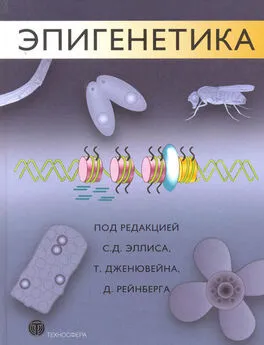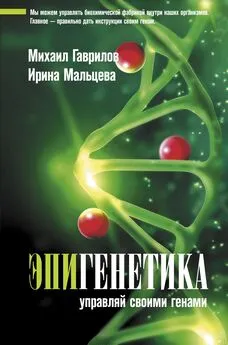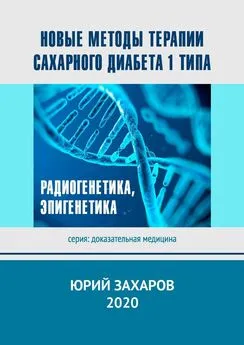Чарльз Эллис - Эпигенетика
- Название:Эпигенетика
- Автор:
- Жанр:
- Издательство:Техносфера
- Год:2010
- Город:Москва
- ISBN:978-5-94836-257-1
- Рейтинг:
- Избранное:Добавить в избранное
-
Отзывы:
-
Ваша оценка:
Чарльз Эллис - Эпигенетика краткое содержание
Книга ярко и наглядно повествует о новой науке общебиологического значения — эпигенетике, а также об ее отдельных областях. В издании представлено описание разных эпигенетических сигналов и механизмов их реализации, а также собственно феномен, история и концепции эпигенетики, ее отдельные механизмы и пути реализации эпигенетических сигналов в клетке. Авторы различных глав данной книги — ведущие в мире специалисты в области эпигенетики, являющиеся, как правило, и основоположниками ее отдельных областей.
Издание будет полезно широкому кругу читателей, интересующихся коренными проблемами живого мира, сущности жизни и молекулярных механизмов ее проявления.
По формирующейся традиции современной российской научной литературы, оригинальное русскоязычное печатное издание неопрятно переведено, отвратительно вычитано и содержит большое количество ошибок, начиная с обложки. Чарльз Дэвид Эллис указан как С. Д. Эллис.
Эпигенетика - читать онлайн бесплатно полную версию (весь текст целиком)
Интервал:
Закладка:
O’Carroll D., Scherthan H., Peters A.H., Opravil S., Haynes A. R., Laible G., Rea S., Schmid M., Lebersorger A., Jerratsch M., et al., 2000. Isolation and characterization of Suv39h2, a second histone H3 methyltransferase gene that displays testis-specific expression. Mol. Cell. Biol., 20:9423-9433
Odegard V.H., Kim S.T., Anderson S.M., Shlomchik M.J., and Schatz D.G., 2005. Histone modifications associated with somatic hypermutation. Immunity 23:101-110.
Ogata N., Ueda K., Kagamiyama H., and Hayaishi O., 1980. ADP-ribosylation of histone H1. Identification of glutamic acid residues 2, 14, and the COOH-terminal lysine residue as modification sites. J. Biol. Chem. 255:7616-7620.
Ogawa H., Ishiguro K., Gaubatz S., Livingston D.M., andNakatani Y., 2002. A complex with chromatin modifiers that occupies E2F-and Myc-responsive genes in G 0cells. Science 296:1132-1136.
Ogawa Y., Ono T., Wakata Y.. Okawa K.. Tagami H.. and Shibahara K.I., 2005. Histone variant macroH2Al.2 is mono-ubiquitinated at its histone domain. Biochem. Biophys. Res. Commun. 336:204-209.
Pantazis P. and Bonner W.M., 1981. Quantitative determination of histone modification. H2A acetylation and phosphoiylation. J. Biol. Chem. 256:4669-4675.
Parthun M.R., Widom J., and Gottschling D.E., 1996. The major cytoplasmic histone acetyltransferase in yeast: Links to chromatin replication and histone metabolism. Cell 87:85-94.
Peters A.H., O’Carroll D., Scherthan H., Mechtler K., Sauer S., Schofer C, Weipoltshammer K., Pagani M., Lachner M., Kohlmaier A., et al., 2001. Loss of the Suv39h histone methyl-transferases impairs mammalian heterochromatin and genome stability. Cell 107:323-337.
Pham A.D. and Sauer F., 2000. Ubiquitin-activating/conjugating activity of TAF n250, a mediator of activation of gene expression in Drosophila. Science 289:2357-2360.
Polioudaki H., Markaki Y.. Kourmouli N., Dialynas G., Theodoro-poulos P.A., Singh P.B., and Georgatos S.D., 2004. Mitotic phosphorylation of histone H3 at threonine 3. FEES Lett. 560:39-44.
Preuss U., Landsberg G., and Scheidtmann K.H., 2003. Novel mitosis-specific phosphorylation of histone H3 atThrl 1 mediated by Dlk/ZIP kinase Nucleic Acids Res. 31:878-885.
Puerta C., Hernandez F., Lopez-Alarcon L., and Palacian E., 1995. Acetylation of histone H2A.H2B dimers facilitates transcription. Biochem. Biophys. Res. Cotnmun. 210:409-416.
Rea S., Eisenhaber F., O’Carroll D., Strahl B.D., Sun Z.W., Schmid M., Opravil S., Mechtler K., Ponting C.P., Allis C.D., and Jenuwein T., 2000. Regulation of chromatin structure by site-specific histone H3 methyltransferases. Nature 406:593-599.
Redon C., Pilch D.R., Rogakou E.P., Orr A.H., Lowndes N.F., and Bonner W.M., 2003. Yeast histone 2A serine 129 is essential for the efficient repair of checkpoint-blind DNA damage. EMBO Rep. A: 678-684.
Rice J.C., Nishioka K., Sarma K., Steward R., Reinberg D., and Allis C.D., 2002. Mitotic-specific methylation of histone H4 Lys, 20 follows increased PR-Set7 expression and its localization to mitotic chromosomes. Genes Dev. 16:2225-2230.
Robzyk K., Recht ]., and Osley M.A., 2000. Rad6-dependent ubiquitina-tion of histone H2B in yeast. Science 287:501-504.
Rogakou E.P., Boon C., Redon C., and Bonner W.M., 1999. Megabase chromatin domains involved in DNA double-strand breaks in vivo. J. Cell Biol. 146: 905-916.
Rogakou E.R, Pilch D.R., Orr A.H., Ivanova VS., and Bonner W.M., 1998. DNA double-stranded breaks induce histone H2AX phosphorylation on serine 139. J. Biol. Chem. 273: 5858-5868.
Roguev A., Schaft D., Shevchenko A., Pijnappel W.W., Wilm M., Aasland R., and Stewart A.F., 2001. The Saccharomyces cerevisiae Setl complex includes an Ash2 homologue and methylates histone 3 lysine 4. EMBO J., 20: 7137-7148.
Rouleau M., Aubin R.A., and Poirier G.G., 2004. Poly(ADP-ribosyl) ated chromatin domains: Access granted. J. Cell Sci. 117: 815-825.
Ruiz-Carrillo A., Wangh L.J., and Allfrey V.G., 1975. Processing of newly synthesized histone molecules. Science, 190: 117-128.
Sanchez-Eisner T., Gou D., Kremmer E., and Sauer F., 2006. Noncoding RNAs of trithorax response elements recruit Drosophila Ashl to Ultrabithorax. Science 311: 1118-1123.
Santos-Rosa H., Schneider R., Bannister A. J., SherriffJ., Bernstein B.E., Emre N.C., Schreiber S.L., Mellor J., and Kouzarides T., 2002. Active genes are tri-methylated at K4 of histone H3. Nature 419: 407-411.
Sarg B., Helliger W., Talasz H., Forg B., and Lindner H.H., 2006. Histone HI phosphorylation occurs site-specifically during interphase and mitosis: Identification of a novel phosphorylation site on histone HI. /. Biol. Chem. 281: 6573-6580
Sassone-Corsi P., Mizzen C.A., Cheung P., Crosio C, Monaco L., Jacquot S., Hanauer A., and Allis C.D., 1999. Requirement of Rsk-2 for epidermal growth factor-activated phosphorylation of histone H3. Science 285: 886-891.
Schiltz R.L., Mizzen C.A., Vassilev A., Cook R.G., Allis C.D., and Nakatani Y., 1999. Overlapping but distinct patterns of histone acetylation by the human coactivators p300 and PCAF within nucleosomal substrates. J. Biol. Chem. 274: 1189-1192.
Schotta G., Ebert A., Krauss V., Fischer A., Hoffmann J., Rea S., Jenuwein T., Dorn R., and Reuter G., 2002. Central role of Drosophila SU(VAR)3-9 in histone H3-K9 methylation and heterochromatic gene silencing. EMBO J. 21: 1121-1131.
Schotta G., Lachner M., Sarma K., Ebert A., Sengupta R., Reuter G., Reinberg D.. and Jenuwein T., 2004. A silencing pathway to induce H3-K9 and H4-K20 trimethylation at constitutive heterochromatin. Genes Dev. 18: 1251-1262.
Schubeler D., Francastel C., Cimbora D.M., Reik A., Martin D.I., and Groudine M., 2000. Nuclear localization and histone acetylation: A pathway for chromatin opening and transcriptional activation of the human p-globin locus. Genes Dev. 14: 940-950.
Schultz D.C., Ayyanathan K., Negorev D., Maul G.G., and Rauscher F.J., III., 2002. SETDB1: A novel KAP-1-associated histone H3, lysine 9-specific methyltransferase that contributes to HP1-mediated silencing of euchromatic genes by KRAB zinc-finger proteins. Genes Dev. 16: 919-932.
Schurter B.T., Koh S.S., Chen D., Bunick G.J., Harp J.M., Hanson B.L., Henschen-Edman A., Mackay D.R., Stallcup M.R., and Aswad D.W., 2001. Methylation of histone H3 by coactivator-associated arginine methyltransferase 1. Biochemistry 40: 5747-5756.
Shiio Y. and Eisenman R.N., 2003. Histone sumoylation is associated with transcriptional repression. Proc. Natl. Acad. Sci. 100: 13225-13230.
Smith E.R., Eisen A., GuW, Sattah M., Pannuti A., Zhou J., Cook R.G., Lucchesi J.C., and Allis C.D., 1998. ESA1 is a histone acetyltransferase that is essential for growth in yeast. Proc. Natl. Acad. Sci. 95: 3561-3565.
Sobel R.E., Cook R.G., Perry C.A., Annunziato A.T., and Allis C.D., 1995. Conservation of deposition-related acetylation sites in newly synthesized histones H3 and H4. Proc. Natl. Acad. Sci. 92: 1237-1241.
Song O.K., Wang X., Waterborg J.H., and Stemglanz R., 2003. An N a-acetyltransferase responsible for acetylation of the N-terminal residues of histones H4 and H2A. J. Biol. Chem. 278: 38109-38112.
Spencer T.E., Jenster G., Burcin M.M., Allis C.D., Zhou J., Mizzen C.A., McKenna N.J., Onate S.A., Tsai S.Y., Tsai M.J., and O’Malley B.W., 1997. Steroid receptor coactivator-1 is a histone acetyltransferase. Nature 389: 194-198.
Stanley J.S., Griffin J.B., and Zempleni J., 2001. Biotinylation of histones in human cells. Effects of cell proliferation. Eur. J. Biochem. 268: 5424-5429.
Stiff T., O’Driscoll M., Rief N., Iwabuchi K., Lobrich M., and Jeggo P.A., 2004. ATM and DNA-PK function redundantly to phosphorylate H2AX after exposure to ionizing radiation. Cancer Res. 64: 2390-2396.
Strahl B.D., Ohba R., Cook R.G., and Allis C.D., 1999. Methylation of histone H3 at lysine 4 is highly conserved and correlates with transcriptionally active nuclei in Tetrahymena. Proc. Natl. Acad. Sci. 96: 14967-14972.
Strahl B.D., Briggs S.D., Brame C.J., Caldwell J.A., Koh S.S., Ma H., Cook R.G., Shabanowitz J., Hunt D.E, Stallcup M.R., and Allis C.D., 2001.Methylation ofhistone H4 at arginine 3 occurs in vivo and is mediated by the nuclear receptor coactivator PRMT1. Curr. Biol. 11: 996-1000.
Strahl B.D.. Grant P.A., Briggs S.D., Sun Z.W., Bone J.R., Caldwell J.A., Mollah S., Cook R.G., Shabanowitz J., Hunt D.E, and Allis C.D. 2002. Set2 is a nucleosomal histone H3-selective methyltransferase that mediates transcriptional repression. Mol. Cell. Biol. 22: 1298-1306.
Su I.H., Basavaraj A., KrutchinskyA.N., HobertO., Ullrich A., Chait B.T., and Tarakhovsky A., 2003. Ezh2 controls B cell development through histone H3 methylation and Igh rearrangement. Nat. Immunol. 4: 124-131.
SukaN., SukaY., CarmenAA, Wu J., andGrunstein M., 2001. Highly specific antibodies determine histone acetylation site usage in yeast heterochromatin and euchromatin. Mol. Cell 8: 473-479.
SunX.J., Wei J., WuX.Y., Hu M., Wang L., Wang H.H., Zhang Q.H., Chen S.J., Huang Q.H., and Chen Z., 2005. Identification and characterization of a novel human histone H3 lysine 36-specific methyltransferase. J. Biol. Chem. 280: 35261-35271.
Sun Z.W. and Allis C.D., 2002. Ubiquitination ofhistone H2B regulates H3 methylation and gene silencing in yeast. Nature 418: 104-108.
Sung Y.J. and Ambron R.T., 2004. PolyADP-ribose polymerase-1 (PARP-1) and the evolution of learning and memory. Bioessays 26: 1268-1271.
Swerdlow P.S., Schuster T., and Finley D., 1990. A conserved sequence in histone H2A which is a ubiquitination site in higher eucaryotes is not required for growth in Saccharomyces cerevisiae. Mol. Cell. Biol. 10: 4905-4911
Tachibana M., Sugimoto K., Fukushima T., and Shinkai Y., 2001. Set domain-containing protein, G9a, is a novel lysine-preferring mammalian histone methyltransferase with hyperactivity and specific selectivity to lysines 9 and 27 ofhistone H3. /. Biol. Chem. 216: 25309-25317.
Tachibana M., Ueda J., Fukuda M., TakedaN., Ohta T., Iwanari H., Sakihama T., Kodama T., Hamakubo T., and Shinkai Y., 2005. Histone methyltransferases G9a and GLP form heteromeric complexes and are both crucial for methylation of euchromatin at H3-K9. Genes Dev., 19: 815-826.
Tachibana M., Sugimoto K., Nozaki M.. Ueda J., Ohta T.. Ohki M., Fukuda M., Takeda N., Niida H., Kato H., and Shinkai Y., 2002. G9a histone methyltransferase plays a dominant role in euchromatic histone H3 lysine 9 methylation and is essential for early embryo-genesis. Genes Dev. 16: 1779-1791.
Читать дальшеИнтервал:
Закладка:








